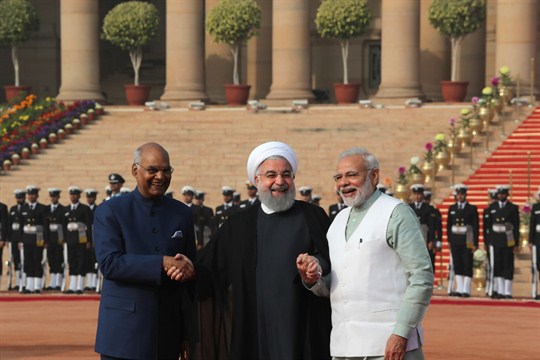Iranian President Hassan Rouhani and Indian Prime Minister Narendra Modi signed nine bilateral agreements, including an 18-month lease of part of the Iranian port of Chabahar, near the Pakistan border, to India for an $85 million development project during a meeting in New Delhi on Feb. 17.
Modi said the port deal would help expand “the centuries-old bilateral relationship”.
In an email interview with World Politics Review, Arshin Adib-Moghaddam, professor in Global Thought and Comparative Philosophies at the School of Oriental and African Studies in London and the recent author of “Psycho-Nationalism: Global Thought, Iranian Imaginations,” explains the significance of the port deal, other areas of collaboration and whether the United States could be a spoiler. Excerpts follow:
WPR: What is the importance of the Chabahar Port deal for both Iran and India?
Arshin Adib-Moghaddam: The port at Chabahar is of immense geostrategic importance for both countries and the lease agreement is yet another indicator of the deepening relations between Iran and India.
As I wrote in my recent book, Iran and India have close cultural links spanning centuries that have repeatedly been translated into economic cooperation and diplomatic achievement. The port deal emerges as a practical outcome of this sound relationship.
For Iran, it is an essential step toward strengthening the “eastern pivot” in the country’s foreign policy, which it has pursued as a strategic preference since the revolution of 1979, when Iran reoriented its foreign policy toward Asia.
Chabahar is Iran’s southernmost city, positioned outside the volatile Persian Gulf, which gives Iran direct access to the Sea of Oman and, from there, to the Arabian Sea.
It is also one of the most socioeconomically deprived areas of Iran, and the port deal is likely to generate more foreign direct investment.
For India, which has secured a lease on parts of the port, this area is of equal geostrategic importance given that it borders Pakistan and could provide a point of transit for Indian goods to the markets of the Middle East and Central Asia that circumvents Pakistan.
Iran is also interested in facilitating more cordial relations between India and Pakistan, and the port project could be a catalyst to that end. Given China’s parallel development of Pakistan’s Gwadar Port just 85 miles to the east, and Iran’s good relations with both China and Pakistan, it may be possible to develop closer ties between the two ports for the economic benefit of all.
What other areas are of mutual interest for Iran and India, and what opportunities are there to deepen bilateral ties?
Iran and India have a range of common interests but also disagreements, such as India’s close relations with the United States and Israel. Nonetheless, both Iran and India have cooperated in Afghanistan to try and suppress the reemergence of the Taliban and Al-Qaeda.
There are many Iranian students who are being educated at Indian universities, and there is a constant exchange in the cultural realm, including joint Iranian-Indian movies that are being filmed and produced in both countries.
Iran is also India’s third-largest supplier of oil, a key for India as its economy continues to grow. There have been efforts to strengthen relations between their militaries as well, including holding joint training and naval exercises.
But relations between Iran and India can’t be reduced to oil and economics.
Both countries are so intimately interconnected that it is almost impossible to explain their national histories without the presence of the other. So there should be more explicit emphasis on cultural diplomacy.
How could relations with the United States affect the deepening ties between Iran and India?
This is one of the most controversial issues in Indian-Iranian relations, but both countries have been rather pragmatic about it.
On the Indian side, New Delhi has not jeopardized its projects with Iran, even under US pressure. On the Iranian side, Tehran has toned down criticism of India’s relations with the US and Israel, not least because until the emergence of [US President] Donald Trump, President Hassan Rouhani himself was busy forging better ties with the Obama administration.
The idea that Iran is a mortal enemy of the US is a myth, as the nuclear agreement shows. The Joint Comprehensive Plan of Action, as it is known, is a very good example for some of the pragmatic policies that Tehran pursues.
But the bellicose tone of the Trump administration has created a dilemma for India.
While India is adamant that the nuclear agreement should remain intact, further US sanctions against Iran, if they are imposed, could challenge some of the economic relations between India and Iran.
However, it should not be forgotten that Iran and India continued to cooperate on issues of mutual interest, even during the most stringent periods of Iranian isolation.
In 2017, India became a full member of Shanghai Cooperation Organization, an intergovernmental organization of Asian states largely dominated by Russia and China, of which Iran is an observer state.
India’s decision to join the SCO demonstrates New Delhi’s strategic orientation both to the east and west, as the country keeps its options open.


